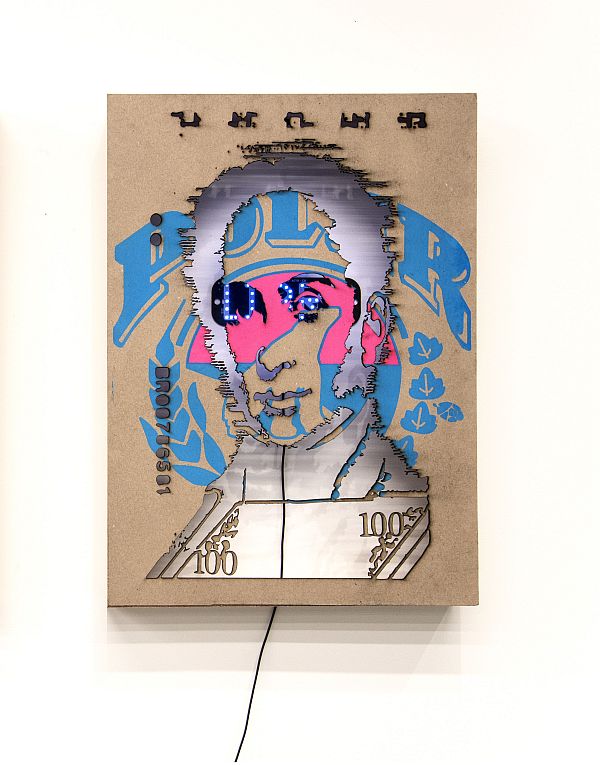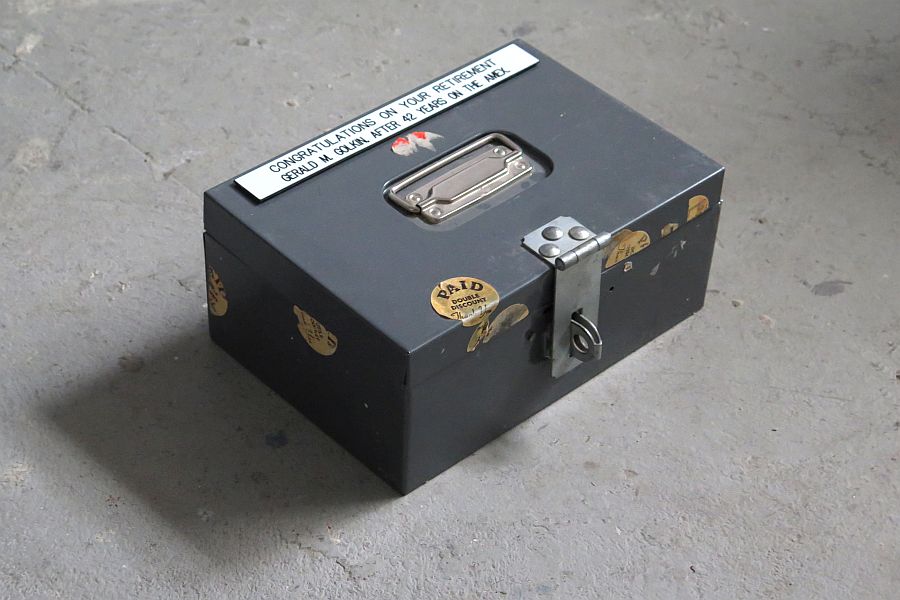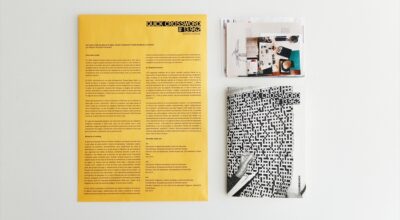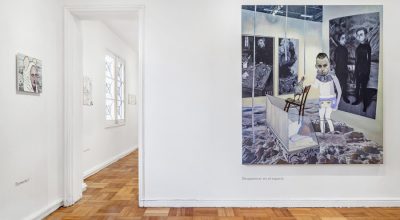
MONEY HAS NO SMELL
Money Has No Smell brings together recent works by Ignacio Gatica, Mariana Parisca, and GabriellaTorres-Ferrer that trace flows of currency to and from the artists’ places of origin -Chile, Venezuela, and Puerto Rico, respectively-, in the process addressing the complexity of globalized and interdependent financial systems. The exhibition is curated by ACOMPI (Jack Radley and Constanza Valenzuela) and mentored by Rosario Güiraldes. It will remain on view at CUE’s gallery space in New York until September 2nd, 2022.

MONEY METAPHYSIC$
“[D]ollars have value only in our common imagination. Their worth is not inherent in the chemical structure of [the paper], or their colour, or their shape. In other words, money isn’t a material reality—it is a psychological construct. It works by converting matter into mind…Money is accordingly a system of mutual trust, and not just any system of mutual trust: money is the most universal and most efficient system of mutual trust ever devised.”—Yuval Noah Harari¹
The Latin phrase pecunia non olet, or “money has no smell” traces back to the policy of collecting tax on urine in ancient Rome. Urine was taken from public toilets and distributed to businesses like tanners and launderers, who paid tax to make use of its ammonia content. The phrase in its original meaning proposes that the source of money does not taint its value.² In a debate on how money works, a postmodernist might say that money can’t be morally neutral; a pragmatist that money is just a medium; and a manifestation coach that money depends on your ability to move from a scarcity to an abundance mindset.
Even if money has no smell, it generates sticky feelings and assumptions. Unexamined beliefs about money can feed paranoia about rigged systems and scams, and paradoxically, give profiteering from uncertainty a network and platform. It reminds me of conspirituality, a portmanteau that captures the shared mistrust of institutions held by both right-wing conspiracy theorists and progressive New Age utopianists.³ The phenomenon of conspirituality—which is visible in vaccine hesitancy and debates about masking since the onset of the COVID-19 pandemic—seems to arise from conditions of imperfect private and public infrastructures, mass neglect and the triaging of care, and the myth of personal responsibility. The compounded global crises of COVID-19 (wage loss, supply chain disruptions, food shortages, access to healthcare, a shadow mental health epidemic, rising inflation, widening economic inequality) exemplify how money entangles the personal with the structural, disproportionately impacting anyone unable to buy their own survival.⁴
Perhaps “money has no smell” refers to how senseless we are to the hegemony of the U.S. dollar, and how overvalued U.S. interests and ideas are—not merely in global markets, but in global politics and culture. In times of crisis, it’s common for messianic visions about money to abound, both in stories spun by large institutions and interpersonally. Yet this social behavior presents a risk of negationism, often erasing and bypassing the very real ways in which neo-imperialist extraction operates through global financial institutions. Maybe “money has no smell” implies a desired paradigm shift, though it’s ambiguous what kind: democratically-regulated central banks, decentralized cryptocurrency utopias, in reparations policies that seek to amend colonial theft and economic marginalization, or solidarity economies that work to redistribute wealth?
Organized by the curatorial duo ACOMPI (Jack Radley and Constanza Valenzuela), the group exhibition Money Has No Smell gathers recent and newly commissioned works on the topic of money and its belief systems by three artists—Mariana Parisca, Ignacio Gatica, and Gabriella Torres-Ferrer. Within this uneasy zeitgeist, the artists channel a sense of disillusionment and a search for spiritual meaning that bring us back to basic questions of what equality, prosperity, sovereignty, and interdependence might look like.


Recurrent in Mariana Parisca’s practice is the hyperinflation of the Venezuelan bolívar, which reached over 1,000,000% in 2018—so devalued that bricks of cash could be exchanged for household items. The currency has had more value as a craft material for streetside souvenirs than at its exchange rate in neighboring Colombia. Parisca concisely relates spiritual belief to money in an altarpiece made by weaving bolívares and palm leaves, using a technique she learned from Venezuelan artisans in Santa Marta, Colombia. The altar functions as a topographic map of Laguna de Maracaibo, where oil was discovered in Venezuela. It recalls the country’s oil-driven economic growth from the 1950s to the 80s and its more recent oil-backed cryptocurrency, the petro, developed to resurrect the economy and circumvent U.S. financial sanctions.⁵ In her practice, Parisca asks, “Is it really unlimited wealth, modernity and nationality that we wanted, or was it sovereignty— freedom from these systems themselves?”⁶
In recent years, Ignacio Gatica has been investigating neoliberal ideology—its language, signs, and signifiers—informed by the neoliberal policies of the US-backed Pinochet dictatorship of 1973-1990 and the intersection of US interventionism and experimentation in Chile.⁷ Gatica presents two works that function together as an assemblage: a ticker and security box. Traditionally, a ticker displays “ticks” that mark the rise and fall of financial value, continuously reporting live during stock trading. The earliest version of a ticker, made in 1867 in New York City, printed stock quotes onto paper tape, but recent electronic tickers wind around public billboards and on news screens. There is a common misconception that ticker data is universal and accurate; when in fact, tickers are often privately owned and moderated. From Gatica’s perspective, tickers have been ritualized into acceptance as a neutral way to read the economy, even though their technology is rather politically and ideologically-charged. Gatica and collaborating programmer Esteban Serrano propose a different kind of ticker, one that forecasts the annual debt through 2025 of countries the World Bank categorizes as middle or low income. Recasting countries as companies, the work nods to the predatory policies of the International Monetary Fund and World Bank, which are historically US and European-led (and whose leaders are not elected). The work also seems to ask if there are more accessible ways to make economic decisions, without relying on prophetic financial technology. Gatica’s accompanying security box, found in a Bronx-based 99 cent store, has a unique placard congratulating broker Gerald M. Golkin for 42 years working at the AMEX building. A micro-monument to an erstwhile career and to the former stock exchange building (which was absorbed by the NYSE in 2009), it stands in for lost experiences, memories, and trans-missions of finance.⁸


Gabriella Torres-Ferrer’s ongoing series Mine Your Own Business typically consist of objects of everydayconsumption (disposable coffee cups, credit cards, and cigarette boxes) along with a microcontroller display (MCU) that presents various information from the Internet, ranging from the current market value of a commodity to the artist’s personal data. As a “real-time networked installation,” Torres-Ferrer’s work interrupts any lasting perception that the virtual is separate from lived experience, or that technology is waste-free. One of their newest works in the series, Untitled (What A Crypton)—with its MCU processing crypto -mining data on a plantain bunch, decaying in real time—specifically focuses on the capitalist-colonial dynamics of the US and its “unincorporated territory,” Puerto Rico. They write, “The first pieces from the series started as cryptocurrency miners, questioning the post-hurricane [Maria] utopian/speculative wave of crypto businesses that seem to take advantage of places in crisis. Are these the best places to deploy decentralized technologies? [The work] also stands in defiance of the huge amounts of energy and computational power bitcoin mining requires; using the minimum energy and computational power scattered into found objects.”⁹
Even as social spheres become politically polarized and individuals more isolated, money continues to order a consensus reality. Yes, money can turn piss into profit, but maybe what makes it feel so transcendental and profound is what Yuval Noah Harari identifies as our mass, depersonalized cooperation with it.¹⁰ Money is based on trust, and humans believe in it more than they do in each other. In that sense, money is spiritual.
Every sincerely held belief system has gatekeepers that facilitate the spiritual integrity of its practices. Lately, gatekeeping has a pejorative valence of disguising a power differential, of relationships that aren’t transparent, which are extractive and non-consensual. The language of finance, debt, and its institutions are indeed esoteric; their argot makes it difficult to access their underlying epistemologies, and importantly, to audit them. Money connects us all, and yet many of us do not understand it because of our discomfort with discussing personal precarity, despite—and perhaps because of—the U.S.’s influential place in world affairs. In forecasting a shared future and in seeking new beliefs, we are each responsible for sorting emotionally manipulative affect from evidence-based information; for making sense of how money mobilizes both structural abuse and our collusion with it.
The artists in Money Has No Smell tell stories about how we collectively understand the value of money in a global context where the U.S. dollar dominates. Is it possible to think deeply about money metaphysics through an American capitalist framework of productivity—with a psychological inclination to prioritize everything on the basis of what it costs us? When it comes to how helpless and hopeless money makes us feel, what else will loosen the earth than accepting that some of us are unprepared to understand money in our own spheres, let alone internalize the scope of our privilege in the balance of global economic justice?


[1] Yuval Noah Harari, Sapiens: a Brief History of Humankind (New York: Harper, 2015). Chapter 10: “The Scent of Money.” 241.
[2] The Oxford English Dictionary of Proverbs, 6th edition (Oxford: Oxford University Press, 2015). 211.
[3] Charlotte Ward and David Voas, «The Emergence of Conspirituality,» Journal of Contemporary Religion 26, no. 1 (January 2011): 103–121.
[4] Disability justice advocate, Beatrice Adler-Boulton: “Under capitalism, you’re only entitled to the survival you can buy.” Beatrice Adler-Boulton and Matthew Remski, “Eugenic Pandemic with Beatrice Adler-Boulton,” Conspirituality, podcast audio, April 28, 2022, [https://podcasts.apple.com/us/podcast/101-eugenic-pandemic-w-beatrice-adler-bolton/id1515827446?i=1000558965675].
[5] Rachelle Krygier, “Venezuela launches the ‘petro,’ its cryptocurrency,” The Washington Post, February 20, 2018, [https://www.washingtonpost.com/news/worldviews/wp/2018/02/20/venezuela-launches-the-petro-its-cryptocurrency/].
[6] Mariana Parisca, “MegaMillions (Infinite Loop),” description from artist website, [https://marianaparisca.com/MegaMillions].
[7] Augusto Pinochet’s dictatorship experimented with neoliberal economic policy but was violently oppressive of dissent. He was charged with human rights abuses in the 1990s. Pascale Bonnefoy, “Documenting US Role in Democracy’s Fall and Dictator’s Rise in Chile,” The New York Times, October 14, 2017, [https://www.nytimes.com/2017/10/14/world/americas/chile-coup-cia-museum.html].
[8] Ignacio Gatica, interview, June 22, 2022.
[9] Gabriella Torres-Ferrer, Mine Your Own Business, description from artist website, [http://gabriellatorr.es/myob/].
[10] Yuval Noah Harari, Sapiens: a Brief History of Humankind (New York: Harper, 2015).
También te puede interesar
Julen Birke:harnero
Julen Birke (Chile, 1973) inaugura el ciclo expositivo 2018 de la Galería Gabriela Mistral con "Harnero", un proyecto de instalación que involucra la acción de harnear, es decir, de separar y clasificar lo “bueno”...
MARTÍN LA ROCHE: QUICK CROSSWORD Nº13.692
"Quick Crossword Nº13.692" es un libro crucigrama del artista chileno Martín La Roche (1988). Esta publicación es parte del proyecto homónimo en el que el artista propone distintas estrategias de resolución al crucigrama rápido...
CAROLINA MUÑOZ: BLANCO UNIVERSAL
Las actitudes de los personajes de Carolina Muñoz poco deben al naturalismo. Sus cuerpos parecen seguir un posado anómalo, como los modelos de Egon Schiele o los actores del Dr. Caligari, pero filtrado por...



